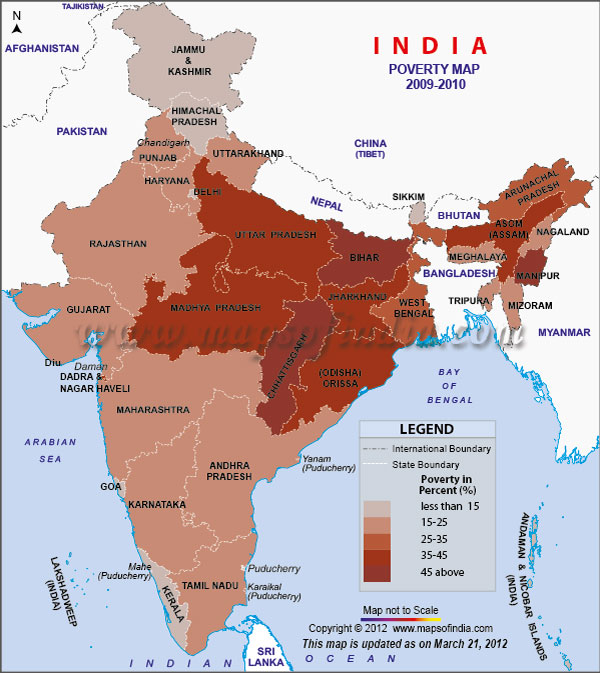For me, the answer is simple: I think of India. Poverty in India is raw.
Despite significant economic progress in the past decade, India is home to about 25 percent of the world's hungry poor. As per the controversial formula An individual above a monthly consumption of Rs 859.6 in urban and Rs 672.8 in rural areas is not considered poor but according to world bank 32.7% live on less than 100Rs per day.A 2010 report by the Oxford Poverty and Human Development Initiative (OPHI) states that 8 Indian states have more poor people than 26 poorest African nations combined which totals to more than 410 million poor in the poorest African countries.
As per estimates released today, the number of poor in India has declined to 34.47 crore in 2009-10 from 40.72 crore in 2004-05 estimated on the basis of controversial Tendulkar Committee methodology.Among religious groups, Sikhs have lowest poverty ratio in rural areas at 11.9 per cent, whereas in urban areas, Christians have the lowest proportion of poor at 12.9 per cent. Poverty ratio is the highest for Muslims, at 33.9 per cent, in urban areas.
According to the findings of the Global Hunger Index 2012 by the International Food Policy Research Institute (IFPRI), India's latest score in the Hunger Index (GHI) has once again returned to the 1996 levels, after showing a minor deterioration between 1996 and 2001.In 1990, India's GHI score as monitored by IFPRI was 30.3, which fell to 22.6 in 1996. But again rose to 24.2 in 2001 and stood at 22.9 in 2012, much closer to 1996 levels. The lower the index, lower is number of incidence of hunger. Poverty is deepest among members of scheduled castes and tribes in the country's rural areas. In 2005 these groups accounted for 80 per cent of poor rural people, although their share in the total rural population is much smaller.On the map of poverty in India, the poorest areas are in parts of Rajasthan, Madhya Pradesh, Uttar Pradesh, Bihar, Jharkhand, Orissa, Chhattisgarh and West Bengal.
REASONS: Large numbers of India's poorest people live in the country's semi-arid tropical region. In this area shortages of water and recurrent droughts impede the transformation of agriculture that the Green Revolution has achieved elsewhere. There is also a high incidence of poverty in flood-prone areas such as those extending from eastern Uttar Pradesh to the Assam plains, and especially in northern Bihar.Poverty affects tribal people in forest areas, where loss of entitlement to resources has made them even poorer. In coastal fishing communities people's living conditions are deteriorating because of environmental degradation, stock depletion and vulnerability to natural disasters.A major cause of poverty among India’s rural people, both individuals and communities, is lack of access to productive assets and financial resources. High levels of illiteracy, inadequate health care and extremely limited access to social services are common among poor rural people. Microenterprise development, which could generate income and enable poor people to improve their living conditions, has only recently become a focus of the government.here are some some more reasons:
REASONS: Large numbers of India's poorest people live in the country's semi-arid tropical region. In this area shortages of water and recurrent droughts impede the transformation of agriculture that the Green Revolution has achieved elsewhere. There is also a high incidence of poverty in flood-prone areas such as those extending from eastern Uttar Pradesh to the Assam plains, and especially in northern Bihar.Poverty affects tribal people in forest areas, where loss of entitlement to resources has made them even poorer. In coastal fishing communities people's living conditions are deteriorating because of environmental degradation, stock depletion and vulnerability to natural disasters.A major cause of poverty among India’s rural people, both individuals and communities, is lack of access to productive assets and financial resources. High levels of illiteracy, inadequate health care and extremely limited access to social services are common among poor rural people. Microenterprise development, which could generate income and enable poor people to improve their living conditions, has only recently become a focus of the government.here are some some more reasons:
- over population
- Shortage of capital and able entrepreneurship
- Corruption
- Political factors
- Unemployment
- Rise in prices of goods
Poverty alleviation programmes in India:
Several poverty alleviation programmes are being implemented by Government. Important among them are:The National Rural Employment Guarantee Scheme (NREGS):The National Rural Employment Guarantee Scheme (NREGS)was launched in February 2006 in 200 most backward district in the first phase and was expanded to 330 districts during 2007-08.At present, 619 districts are covered under NREGS.
Swarnjayanti Gram Swarozgar Yojana(SGSY):Swarnjayanti Gram Swarozgar Yojana(SGSY) was launched in April 1999 after restructuring of the Integrated Rural Development Programme (IRDP) and allied programmes. It is a self-employment programme for the rural poor. The objective of the SGYS is to bring the assisted swarozgraris above the poverty line by providing them income-generating assets through bank credit and Government subsidy.
Swarnjayanti Gram Swarozgar Yojana(SGSY):Swarnjayanti Gram Swarozgar Yojana(SGSY) was launched in April 1999 after restructuring of the Integrated Rural Development Programme (IRDP) and allied programmes. It is a self-employment programme for the rural poor. The objective of the SGYS is to bring the assisted swarozgraris above the poverty line by providing them income-generating assets through bank credit and Government subsidy.
Swarnjayanti Gram Swarozgar Yojana(SGSY):Swarnjayanti Gram Swarozgar Yojana(SGSY) was launched in April 1999 after restructuring of the Integrated Rural Development Programme (IRDP) and allied programmes. It is a self-employment programme for the rural poor. The objective of the SGYS is to bring the assisted swarozgraris above the poverty line by providing them income-generating assets through bank credit and Government subsidy.
Swarnjayanti Gram Swarozgar Yojana(SGSY):Swarnjayanti Gram Swarozgar Yojana(SGSY) was launched in April 1999 after restructuring of the Integrated Rural Development Programme (IRDP) and allied programmes. It is a self-employment programme for the rural poor. The objective of the SGYS is to bring the assisted swarozgraris above the poverty line by providing them income-generating assets through bank credit and Government subsidy.
Swarna Jayanti Shahari Rozgar Yojana(SJSRJ)
Swarnjayanti Gram Swarozgar Yojana(SGSY)
Direct cash transfer
Swarnjayanti Gram Swarozgar Yojana(SGSY)
Direct cash transfer
Problems of Poverty allevitation:
Indian Government certainly fails to achieve success in poverty alleviation programme even though they allocate substantial portions of their budget to this cause. Most development schemes are poorly targeted. Most development schemes are poorly targeted; like using a hammer where a tooth pick is required. The chosen tool is not only too expensive, but also ineffective.Rahul Ghandhi stated that only 5% of the government spending reaches its intended recipients because there is a efficiency ratio of 20:1, every Rs.20 spent, has the effect of Rs.1.
If you have Ideas then plz share so we can help our country!!!!thanxx


